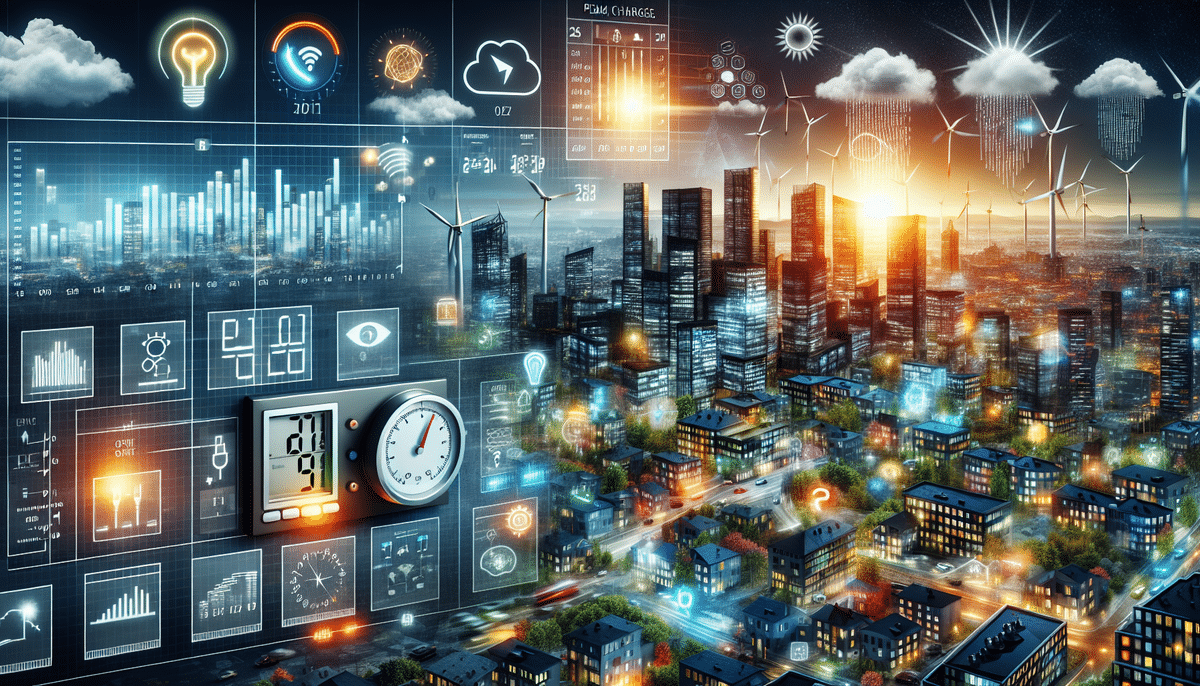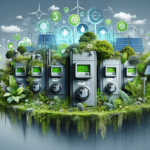What to Expect for Peak Charges in 2023
In today's world, energy consumption is an essential part of everyday life. From powering homes and businesses to fueling cars and electronics, energy use is constantly on the rise. However, with increasing demand for energy comes the phenomenon of peak charges.
Understanding the Concept of Peak Charges
Peak charges, also known as peak demand charges, refer to the additional fees charged for electricity use during periods of high demand. Typically occurring in the morning and evening, these charges incentivize customers to reduce energy usage during peak hours to prevent overloading the energy grid.
Peak charges apply not only to residential customers but also to commercial and industrial sectors. Businesses operating during peak hours, such as restaurants and retail stores, may face higher rates due to increased energy consumption. To avoid these charges, businesses can implement energy-efficient practices and technologies, such as LED lighting and smart thermostats.
Additionally, peak charges can vary based on location and time of year. Regions with extreme weather conditions, like hot summers or cold winters, may experience higher peak charges due to increased demand for heating or cooling. Awareness of these variations allows customers to adjust their energy usage accordingly.
The Factors That Influence Peak Charges
Several factors influence peak charges, including:
- Energy Demand: Higher demand during specific periods leads to increased charges.
- Transmission and Distribution Costs: The expenses associated with delivering electricity affect peak charges.
- Availability of Resources: Limited energy resources during peak times can drive up costs.
Extreme weather conditions can also cause surges in energy consumption, leading to higher peak charges. Industries with high energy needs, such as manufacturing plants, data centers, and hospitals, are particularly vulnerable.
Some energy providers offer time-of-use pricing plans, incentivizing customers to consume energy during off-peak hours to reduce overall costs and alleviate peak demand.
Historical Trends in Peak Charges and Their Impact on Consumers
Historically, peak charges have been on the rise due to increasing energy demands and limited resources, resulting in higher electricity bills for consumers and financial stress for businesses. According to the U.S. Energy Information Administration, peak electricity demand in the U.S. has grown steadily over the past decade.
Recent advancements in renewable energy sources and energy storage technologies show promise in reducing peak charges. Utilizing solar panels, wind turbines, and battery storage systems allows consumers and businesses to generate and store their own energy, reducing reliance on the grid during peak hours. This not only saves money but also promotes a more sustainable energy future.
How Peak Charges Vary Across Different Industries
Peak charges can significantly vary across industries:
- Healthcare: Hospitals require constant energy for critical operations, leading to higher peak charges.
- Data Centers: Continuous server activity results in substantial energy use during peak periods.
- Retail and Hospitality: Businesses like restaurants and retail stores can manage energy use to mitigate peak charges.
Location also plays a role; industries in urban areas with high energy demand may face higher peak charges compared to those in rural regions with lower demand.
Predictions for Peak Charges in 2023
As of 2023, peak charges are projected to increase by approximately 40% compared to previous rates, driven by rising energy consumption and limited resources. The growing adoption of electric vehicles (EVs) significantly contributes to this surge. Increased EV usage elevates electricity demand, particularly during peak charging times, straining the energy grid and resulting in higher peak charges.
Efforts to address rising peak charges include investments in renewable energy sources and advancements in energy storage technologies. Solar and wind power installations, coupled with battery storage, help reduce dependency on the grid, offering a buffer during high-demand periods.
The Potential Economic Impact of Higher Peak Charges on Businesses and Consumers
Higher peak charges can profoundly impact both businesses and consumers:
- Businesses: Rising energy costs can erode profit margins, making it challenging for small and medium-sized enterprises to operate and grow.
- Consumers: Increased energy bills reduce disposable income, limiting spending capacity and negatively impacting the broader economy.
Moreover, elevated peak charges can decrease business competitiveness. Higher energy costs may necessitate price increases, making businesses less attractive to consumers and potentially leading to a loss of market share.
Investing in energy-efficient technologies and practices can help mitigate these effects, leading to long-term savings and environmental benefits. Government incentives and subsidies further encourage the adoption of sustainable energy practices.
Strategies for Mitigating the Effects of High Peak Charges on Your Business
Businesses can employ several strategies to reduce the impact of peak charges:
- Energy Management Systems: Implementing systems to monitor and optimize energy usage.
- Renewable Energy Investments: Installing solar panels or wind turbines to generate on-site energy.
- Operational Shifts: Moving energy-intensive operations to off-peak hours to take advantage of lower rates.
Additionally, negotiating favorable rates with energy providers, exploring demand response programs, and investing in energy storage solutions like batteries can further alleviate peak charge burdens.
Innovations in Energy Technology That Could Affect Future Peak Charges
Emerging energy technologies have the potential to transform energy consumption and peak charge management:
- Energy Storage: Advanced batteries and flywheels can store excess energy during off-peak times for use during peak periods.
- Smart Grids: These grids use real-time data to balance energy supply and demand efficiently.
- Electric Vehicles: Smart charging systems can schedule EV charging during off-peak hours.
Moreover, the increasing efficiency and cost-effectiveness of renewable energy sources like solar and wind power can significantly reduce reliance on traditional energy grids, thereby lowering peak charges.
Comparing Peak Charges Across Different Regions and Countries
Peak charges vary widely across regions and countries due to differences in energy infrastructure, demand, and available resources:
- United States: High energy consumption leads to substantial peak charges, particularly in states with extreme weather conditions.
- Australia: Similar to the U.S., Australia experiences high peak charges due to significant energy demands.
- Iceland: Abundant geothermal energy resources result in lower peak charges.
Other factors influencing regional peak charges include government policies, availability of renewable energy resources, and the overall efficiency of the energy grid.
The Role of Government Regulations in Managing Peak Charges
Government regulations are pivotal in managing peak charges through various policies:
- Feed-In Tariffs: Encourage the adoption of renewable energy by guaranteeing a fixed price for energy producers.
- Energy Efficiency Standards: Mandate the use of energy-efficient technologies in buildings and industries.
- Demand Response Programs: Incentivize consumers to reduce energy usage during peak periods.
These regulations not only help in controlling peak charges but also promote sustainable energy practices and the reduction of carbon emissions.
Expert Opinions on the Future of Peak Charges and How to Prepare for Them
Industry experts agree that effective management of energy consumption during peak hours will be increasingly crucial. Strategies recommended include:
- Investing in energy-efficient technologies to lower overall energy usage.
- Adopting renewable energy sources to generate on-site power.
- Implementing smart energy management systems for real-time monitoring and adjustment.
Companies that proactively manage their energy consumption are better positioned to thrive in an energy-conscious market, reducing costs and enhancing sustainability.
Managing Energy Usage to Avoid High Peak Charges
To avoid high peak charges, businesses and consumers can adopt the following practices:
- Energy-Efficient Technologies: Use LED lighting, energy-efficient appliances, and smart thermostats.
- Shift Operations: Schedule energy-intensive tasks during off-peak hours to take advantage of lower rates.
- Renewable Energy Investments: Generate your own electricity through solar panels or wind turbines.
By implementing these strategies, businesses and individuals can significantly reduce their peak energy usage and associated costs.
How Businesses Can Pass On the Cost of High Peak Charges to Customers
Businesses facing high peak charges can adopt time-of-use pricing models to pass some of the costs to customers. This model involves:
- Charging higher rates during peak hours.
- Offering lower rates during off-peak times.
This pricing strategy incentivizes customers to adjust their energy usage patterns, reducing peak demand and alleviating the financial burden on businesses.
The Impact of Renewable Energy Sources on Future Peak Charge Trends
The adoption of renewable energy sources is poised to significantly influence future peak charge trends. Key impacts include:
- Increased Energy Independence: Generating and storing renewable energy reduces reliance on the grid during peak times.
- Cost Reduction: The decreasing costs of solar and wind technologies make renewable energy more accessible.
- Environmental Benefits: Reduced reliance on fossil fuels lowers carbon emissions and promotes sustainability.
As more businesses and consumers invest in renewable energy, the overall demand on the grid during peak periods diminishes, leading to stabilized or reduced peak charges.
Conclusion
Peak charges present a significant challenge for both businesses and consumers. With rising energy demand, it is imperative to manage energy consumption during peak hours to avoid excessive costs. Investing in energy-efficient technologies, adopting renewable energy sources, and shifting operations to off-peak times are effective strategies to mitigate the impact of peak charges. By proactively addressing energy consumption patterns, companies and individuals can achieve financial savings and contribute to a more sustainable energy future.




















